Do you love the smell of the sea? 🌊
Or do you dislike that “fishy” smell? 🐟
Any thoughts on seaweed? 🌿

Seaweed…. 🤔
Funny name to begin with, right?!
Another name for it is algae, which seems just as mysterious.
What do you know about this organism beside it being slimy, slippery, slightly smelly and somewhat sssstrange?
Did you know it’s also deliciousssss? [Enough word play with the letter “s” now.]
Yes, there are various types of seaweed that are EDIBLE! 🍽
🤢
Did I just see you squint in disgust?
Why????
Open your eyes to see the fascinating culinary aspects of seaweed!
In Korea, seaweed is an essential element in the local cuisine. Facilitated by its geography, the country has established an intricate relationship with the ocean, including a dependence on marine products. 🌊🌿🦐🐟 Accordingly, certain dishes featuring seaweed are widely distributed all over the peninsula. Regions that are located closer to the coast have naturally developed a more diverse cuisine featuring seaweed and other aquatic organisms.
Over all, Korea exhibits a rich tradition of consuming seaweed and there are many different kinds which characterize this country’s cuisine. 🇰🇵🍚🥢🇰🇷 There’s no need to be afraid or repelled by its appearance!
Let me explain all you need to know about Korean seaweed! Learn how to eat seaweed in Korea and how to enjoy the taste of seaweed. There are many reasons as to why eating seaweed is good for you – ESPECIALLY on a vegan or vegetarian diet! 💪🌱 After all, this post is an introduction to the most common types of edible seaweed in Korea! 🧐 “Lesson about Korean Seaweed 101” – here we go!
Korea’s best known and popular seaweed: Kim / Gim 김

So you know the most common surname in Korea is Kim, right?*
Funny enough, the most common seaweed in Korea goes by the same name! Only the pronunciation of the name “김” is slightly different: The seaweed is referred to as “gim” with a soft starting consonant and a long vowel, while the family name is a rather short and crisp “kim”.** Scientifically, this seaweed is referred to as Porphyra (genus) and classified as a red algae. 🔴
If this seems too complicated already, here’s an easier explanation: It is the same seaweed that is used in Japanese sushi 🍣 or onigiri 🍙! The Japanese name for it is nori (海苔). Does it sound familiar now?
In Korean cuisine, gim is likewise used as the outer wrapping of Kimbap (김밥), the Korean equivalent to sushi. However, it’s rather a snack or an appetizer than a full dish. Typical for Korea is also that the dried sea laver is roasted! 🔥 That means, there are umami AND roasted aromas in Korean gim! [I don’t NEED fish in my sushi for that, thank you.]
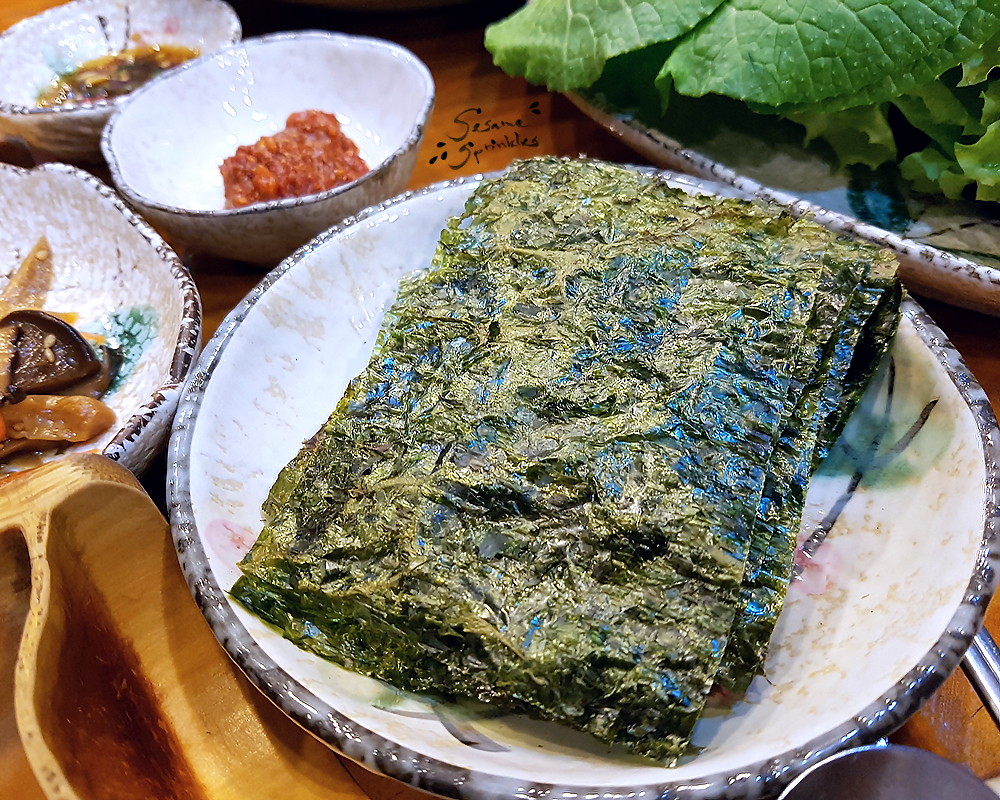
During a regular Korean meal, sheets of gim cut into the size of playing cards may be served as a side dish. 🃏 The paper-thin layers of roasted seaweed are crispy, dark (almost black) in color and often seasoned with sesame oil and salt. Koreans roll small portions of rice into slices of gim as they eat. These tiny wraps of rice and seaweed are the most simple form of Kimbap, which literally means “gim and rice” (김밥).
As an alternative to thin sheets of layered seaweed, you can find gim also in the shape of small crumbly pieces, which have been roasted and seasoned e.g. with oil, salt and sugar. This style of preparing gim is called gim-jaban (김자반). Gim-jaban may appear as a side dish that can be eaten as it is with the spoon or mixed into your individual bowl of rice. 🍚 But perhaps it is more frequent as a topping on various kinds of dishes. It’s the “black stuff” that garnishes Bibimbap (비빔밥) 🥗, Jumeok-bap (주먹밥) 🍙 and some noodle dishes. 🍜


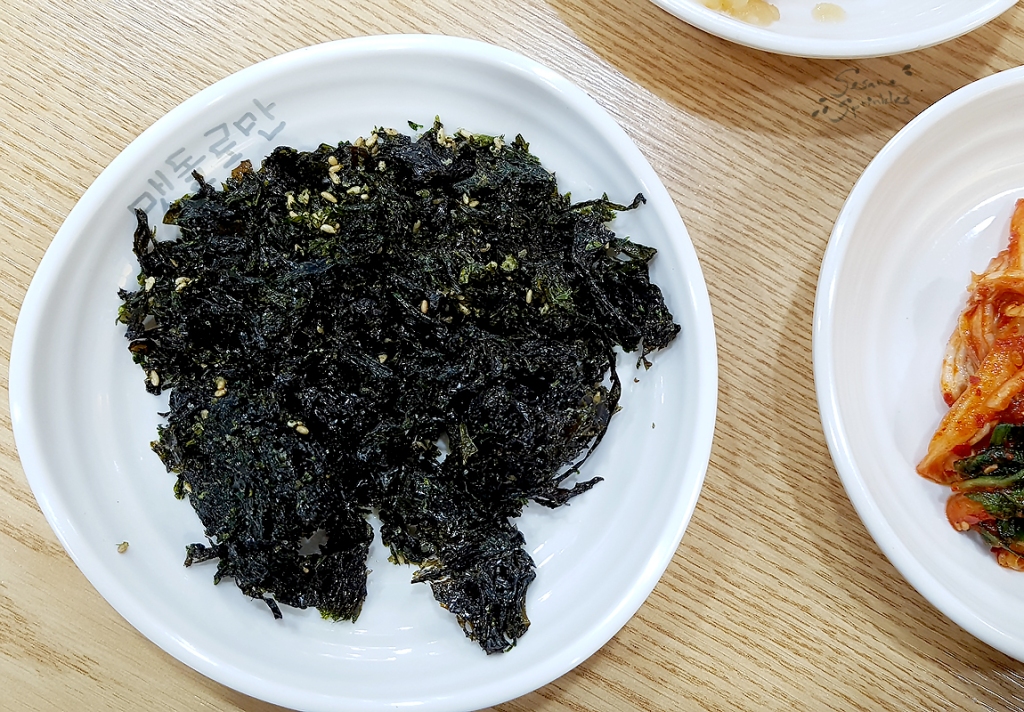
Another food made from this seaweed is gim-bugak (김부각). It consists of several sheets of gim, which are glued together with rice paste. Next, the battered seaweed is deep-fried or toasted, so that it puffs up and becomes crunchy. You can find gim-bugak served as a side dish in some restaurants or sold packaged in the snack section of supermarkets or convenience stores. The seasoning in gim-bugak varies by family and brand – some use fish powder for additional flavor, so check the ingredients if you want to know what you’re eating. ⚠️🐟

There are more ways of serving gim, but above are the most common ones in Korea. In the southern province Jeollanam-do, for example, fresh gim is cooked into a thick soup called gim-guk (김국). 🥣 Here, taste and texture are quite different from “conventional” gim dishes… [Slimy and gooey, to be more precise. 😬]
Overall, most people who newly encounter the culinary side of seaweed find it easiest to appreciate the taste of Korean gim. Especially when it’s roasted and seasoned, gim is light and crispy with an addictive sweet-and-salty flavor. Some people think of it as edible paper that is simply fun to eat. Others munch away on it when they have a craving for something savory like potato chips!

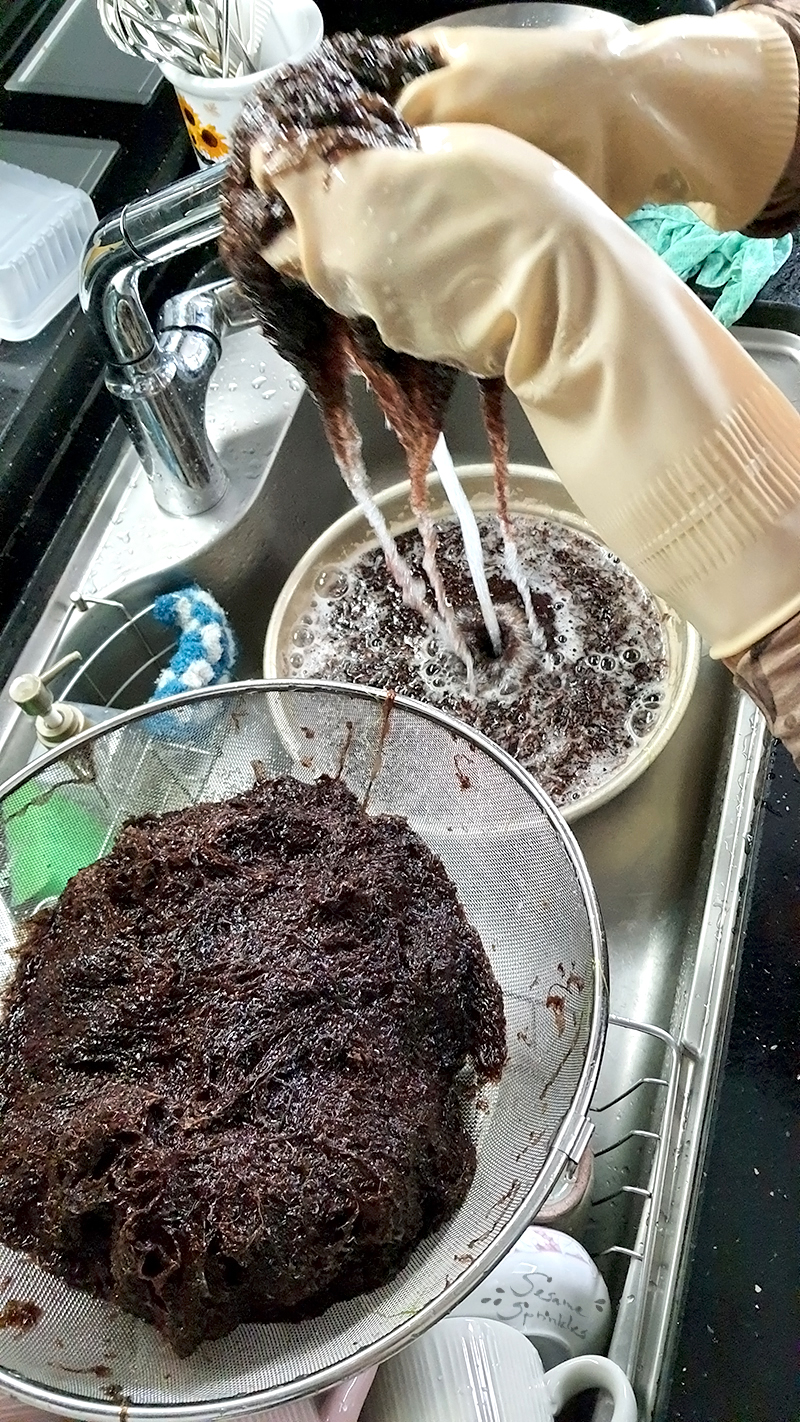
Celebrate birthdays and fail exams with seaweed: Miyeok 미역
What do you think of the scientific name of this seaweed?
Undaria pinnatifida
Any ideas?
It belongs to the class of brown algae. 🟤
Still no clue? What if I give you the hint “miso soup”?
Anyone who’s been to a Japanese restaurant knows this soup, since it is typically served as a side or a starter there. It’s the seaweed inside miso soup what I’m referring to! It’s called wakame in Japanese and miyeok (미역) in Korean.

In Korean cuisine, miyeok is also the protagonist in a classic soup: Miyeok-guk 미역국. This soup normally contains seafood or beef 🐟🐮 and it is therefore not veggie-friendly… 🚫🌱 Nevertheless, it’s important to know this dish, because it is an integral part of Korean culture: Instead of having cake for birthday, Koreans traditionally eat miyeok-guk. (Nowadays, some Koreans have adopted the Western tradition of birthday cake 🎂 – in addition to seaweed soup!)
So Koreans celebrate birthdays with warm, savory seaweed soup. 🥳🥣 For breakfast. Why, oh why. 😱 You might wonder.
The reasons are not just that it tastes good and is healthy! To find the answer, we need to go back to the actual day of birth. 👶🍼 After giving birth, a mother in Korea is advised to eat miyeok-guk in order to replenish her body with vital nutrients. And she needs to eat it for days on end (7 weeks?!) without getting sick of it! By eating miyeok-guk on birthdays, Koreans commemorate the time their mother had to recover when they were a newborn. 🤱 An expression of filial piety? An opportunity for self-reflection and more conscious eating, to say the least. 🙏
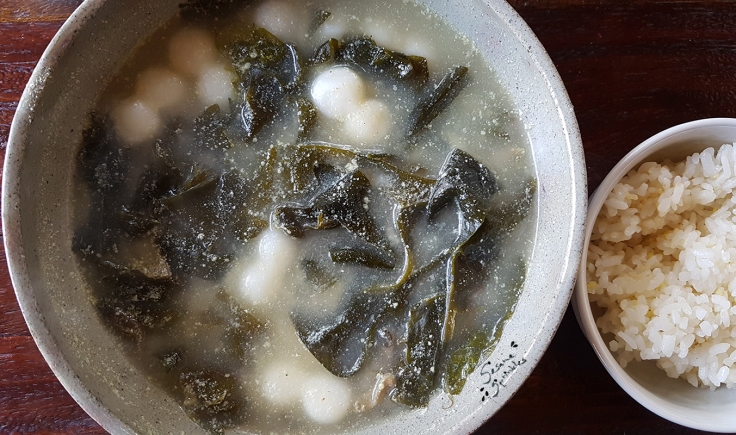
Regardless of that, miyeok-guk can be enjoyed throughout the year! Technically, you can eat Korean seaweed soup any time – with ONE exception. If you eat miyeok-guk before an exam, chances are you flunk it! 🚫🔖 According to Korean superstition, you can fail a test and blame it on the food. Why do Koreans believe that you fail an exam when eating miyeok-guk? Because seaweed is slippery (not to say slimy) and likewise, your luck will slip out of your hands and slither away… 🐌 So what food SHOULD you eat on a day you take a test? Korean rice cakes (tteok 떡)! 🍡 Because they are sticky and thus help in (figuratively speaking) “holding on” to success! ✅🔖 Eating glutinous rice cakes on the day of your test? You might as well eat them while relaxing in bed!*** 🛌🍡📚 [The author does not assume any liability for this being a reliable technique to pass exams!]
Beside being the main ingredient in Korea’s birthday food and for bad luck on exam days, miyeok is also used in salads. There are the so-called haecho-saeleodeu (해초샐러드, literally “seaweed salad”) as well as miyeok-muchim (미역무침) which consist of seaweed mixed with seasonings and vegetables. Both are normally served cold as vegan side dishes. 🌱




Next, there are dishes made from miyeok-julgi (미역줄기), which refers to the trunk or stem-like part towards the base of the algae, close to where it is attached to the ground. These seaweed “stems” are thick and fibrous, and have lighter color and a chewier texture. They are usually cut into thin slices, and stored in dried or salted form. A common vegan side dish called miyeok-julgi-bokkeum (미역줄기볶음) consists of long strips of seaweed which are pan-fried until soft.

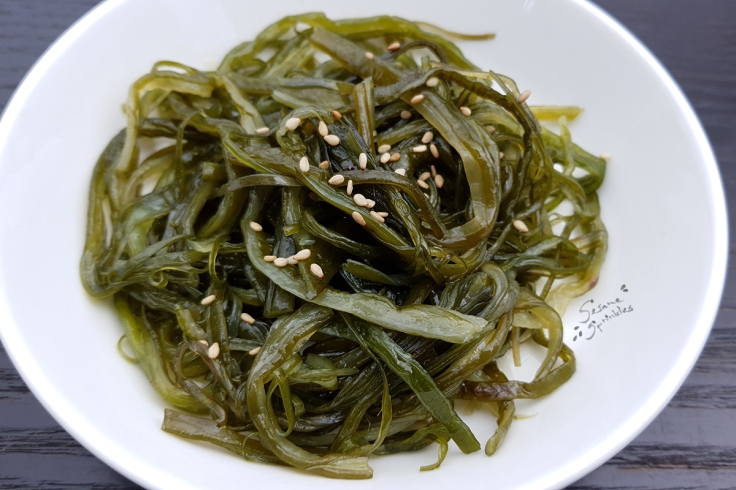

There is also miyeok-gwi (미역귀), which translates to “ears of miyeok“. 👂 Remotely resembling ears (or rather frills?), they are what grows on the “stems” when the seaweed wants to propagate (sporophylls). Miyeok-gwi is produced in smaller quantities and thus more expensive than other parts of this seaweed. It is usually sold in dried form and can be eaten as it is – it’s a salty snack that is fun to chew on! Alternatively, after re-hydrating it by soaking it in cold water, miyeok-gwi can be added to seaweed soup like miyeok-guk or used as an ingredient in seaweed salad.
With regards to taste and texture, miyeok is quite diverse and versatile, depending on a couple of factors:
1) The method of preparation. If miyeok is properly cooked, e.g. in soup or a frying pan, it develops a soft and slippery texture. The longer it is cooked, the softer it gets. In cold seaweed salads, however, miyeok is rather chewy.
2) Each edible part of miyeok has its own characteristics. The thick miyeok-julgi tend to be fibrous, sometimes even tough to chew. On the other hand, the “leafy” part of the seaweed can be as thin as paper and silky soft, while “miyeok ears” are almost cartilaginous in texture.
3) Since this type of seaweed is able to absorb flavors, it will bear the characteristic taste of the respective seasoning. Correspondingly, miyeok may taste sweet and sour in cold seaweed salads, but it will be savory and mild in miyeok-guk.
Invisible but essential seaweed: Dasima 다시마
Last but not least, we need to talk about dasima (다시마). As a seaweed of the genus Laminaria, it also belongs to the family of brown algae. 🟤 In English speaking spheres, it may be considered as kelp or kombu (from Japanese). It is easily overlooked, even though it is an essential in many Korean dishes ranging from stew, sauce to soup. A key ingredient present in Korea’s daily food.
Dasima is most important in Korean soup stocks, often in combination with dried anchovy (myeolchi 멸치). 🐟 One piece of dried kelp and a couple of anchovies are boiled in water until the broth is properly infused with flavor. Afterwards, both seaweed as well as anchovies are removed and the remaining liquid is used in soups, stews or sauces.**** The liquid is generally referred to as dasima-[myeolchi-]yuksu (다시마[멸치]육수), although more ingredients may be added to the base of water, kelp and anchovies. In other words, there is seaweed AND fish hidden in almost all Korean foods that use some kind of broth. ⚠️ [So sneaky…..]
And here’s why: By adding nutrients and flavor, it can turn anything into a more wholesome dish with complex aroma. Koreans are generally convinced of the previous statement. When you ask for food to be cooked with clear water instead, you will get an uncomprehending look. ☹️ “But it won’t taste of ANYTHING!” If you’re lucky or you win the ensuing discussion, you can get your order customized. ✌️🌱 If neither is the case, your request may get refused or the kitchen forgets to cook your dish separately. 🚫🌱
Both, dasima and anchovies (among other ingredients!) are natural flavor enhancers in Korean cuisine. In fact, this kind of seaweed led to the scientific discovery of umami as one of the five tastes!
Another characteristic trait of dasima is that it develops a mucilaginous (=slimy) coating when soaked in water.
After cooking, the texture of dasima is somewhat leathery and the gel-like coating has disappeared.
While dasima normally acts in the background -like a secret ingredient- of Korean cooking, there are cases of it making a solo appearance. Every once in a while you might stumble across dasima-ssam (다시마쌈), which is a vegan-friendly side dish. It features slices of cooked kelp – as plain as can be (not to say “naked”). The seaweed is accompanied by a seasoning sauce, e.g. the spicy, sweet AND sour tasting cho-gochujang (고추장), which you can dress it with! 👚 According to preference, you can dip pieces of dasima into the sauce or use the broad, leaf-like slices to make little wraps (ssam 쌈) filled with rice or vegetables.
Similar to the gim-bugak (김부각) mentioned above, there exists also dasima-bugak (다시마부각), pieces of crispy dasima with a rice-based coating. An alternative is dasima-twigak (다시마튀각), which consists of fried dasima with sugar and salt.


Why eating seaweed is good for you
Beside gim, miyeok and dasima, other kinds of edible seaweed are either less common in daily eating or only available regionally / seasonally. To come to a conclusion [this could turn into a never-ending story!], there are many, many types of (edible) seaweed. In Korea alone, more than a DOZEN different species of algae are used in the local cuisine!
Other species of edible Korean seaweed and information about algae in general can be found in the sequel post “Seaweed 102“. The images below convey only a glimpse of their diversity! 👇 Fascinating! 🤓 And flavorful! 😋


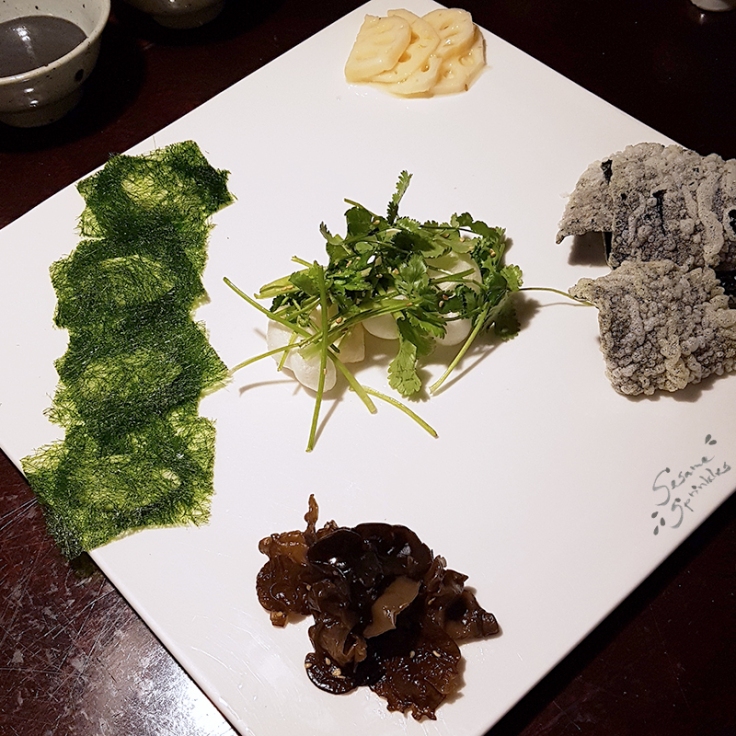


From personal [and own] experience, I know that seaweed does not appeal to anyone. Or anytime.
You don’t have to eat Korean seaweed soup for breakfast on your birthday, but how about giving it a chance at least? Each kind of seaweed comes with a different set of looks, smells, flavors, textures and nutrients!
Now, from among these three most common seaweeds of Korean cuisine, do you have a personal favorite? 🤗
Is it Gim – the gets-along-with-everyone-type? 👼
Or do you prefer Miyeok because she is so diverse in taste and texture? 👩🏾🎤
Or do you like Dasima, who’s somewhat secretive yet powerful? 🦹🏼♀️
Also, did you make experiences with seaweed in a different country? What and how did you eat seaweed there? 🧐
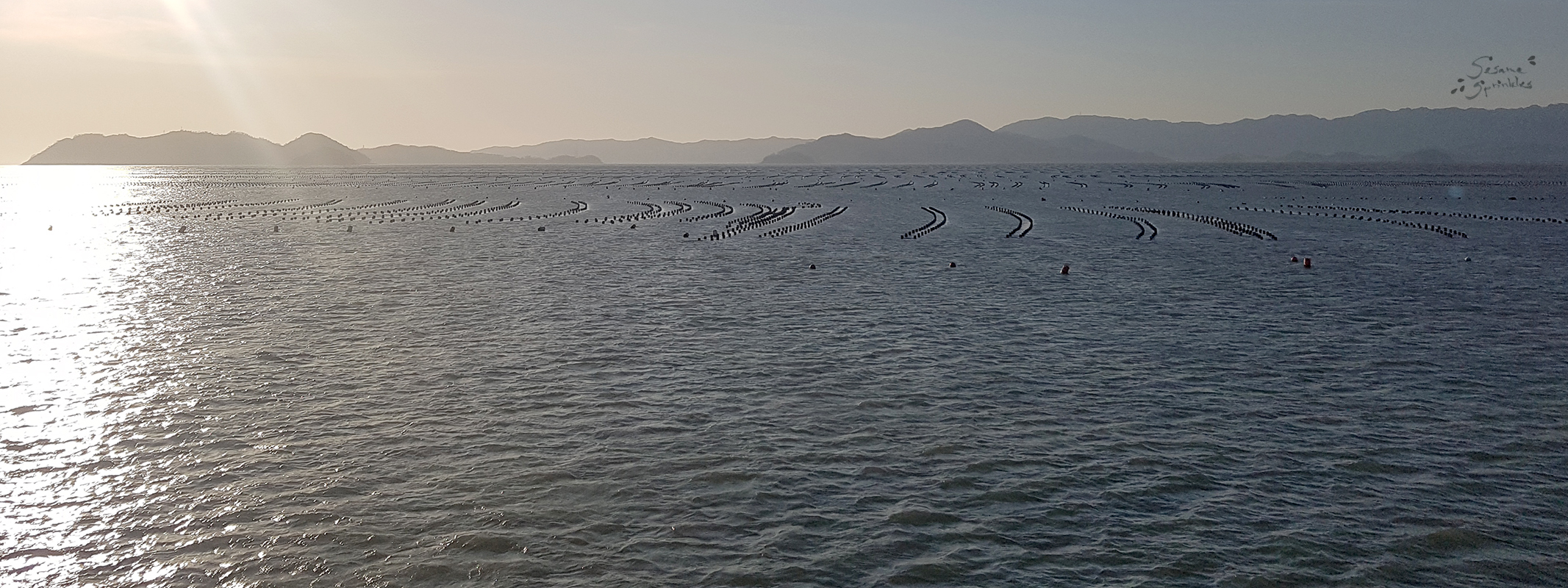
****
Notes by the author
*) More than 20% of South Korea’s population has the family name Kim / Gim (김 金).
**) The two common transcription systems for Korean, McCune-Reischauer and Revized Romanization, allow the spelling “gim” as well as “kim” for the Korean letters “김”.
***) Reference to the Korean proverb “eating rice cake while lying down” (누워서 떡 먹기), which is synonymous with the expressions “easy as pie” or “a piece of cake” in English language. [An entire article about Korean proverbs and expressions related to food is currently in progress! 🤓]
****) This broth may be compared to practices in other cultures, e.g. 🇩🇪German Suppengrün (celeriac, carrot, leek, etc.), Creole cuisine’s holy trinity, mirepoix, Maggi cubes, Vegemite / Marmite, soy sauce, 🇻🇳Vietnamese fish sauce.
[The author does not assume any liability for health claims.]
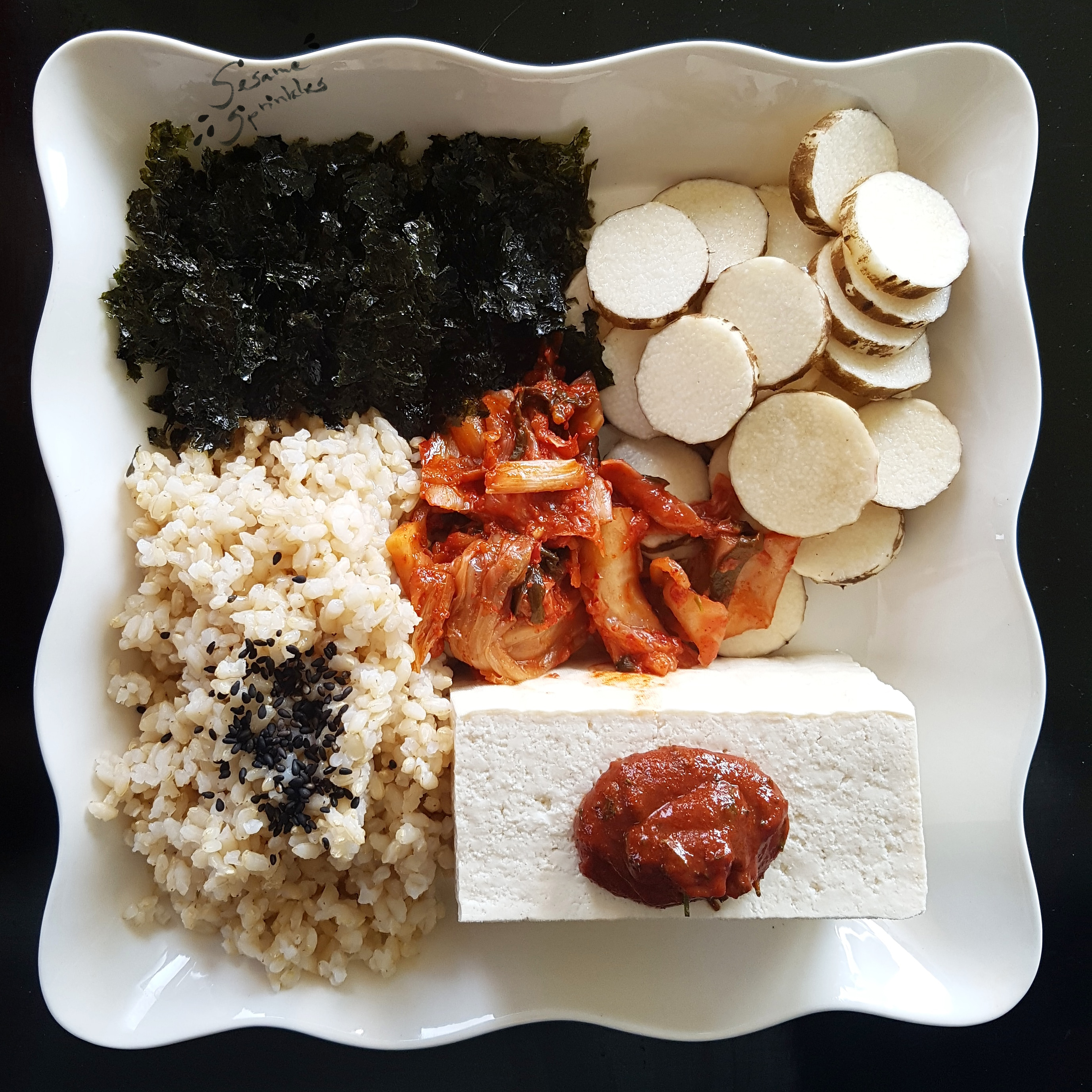



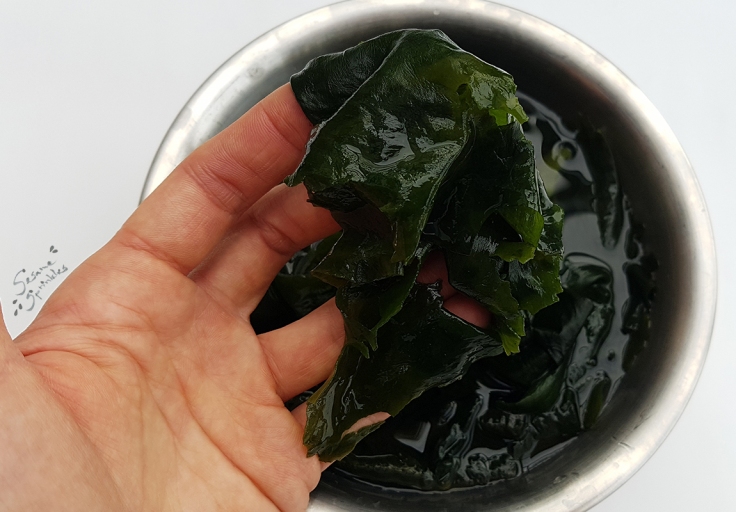



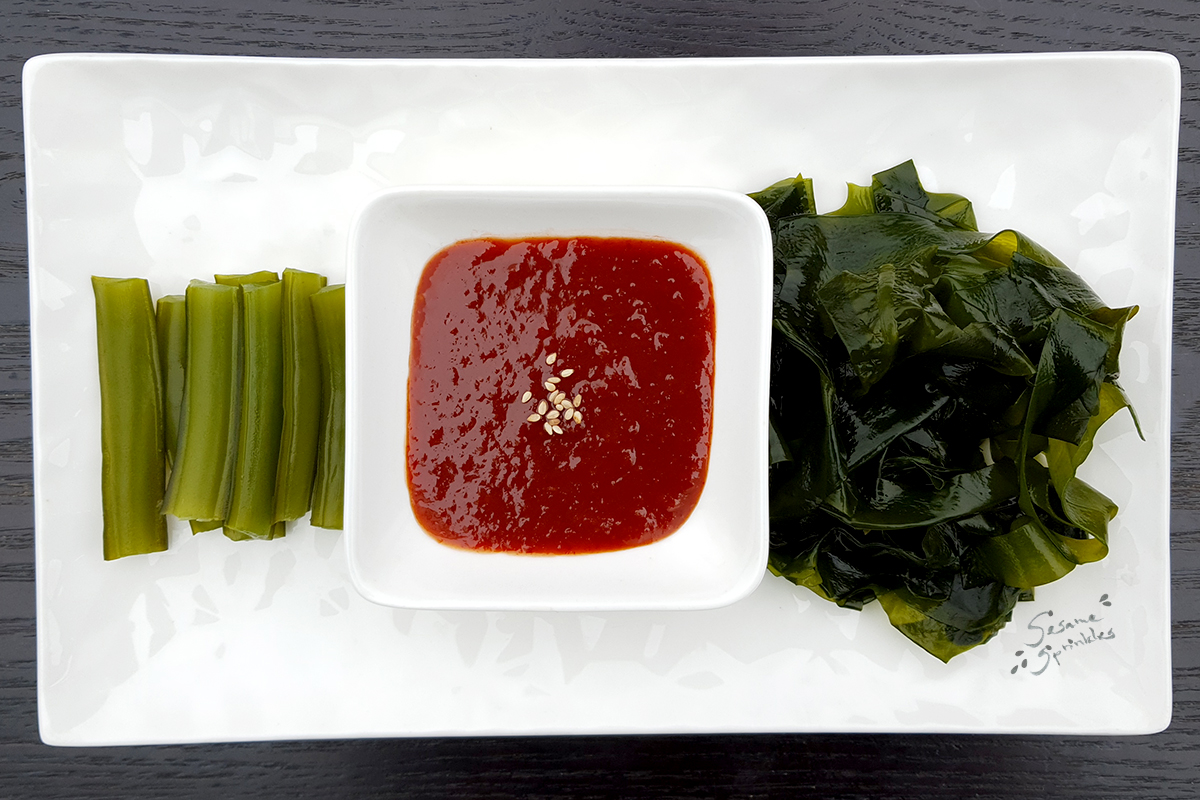




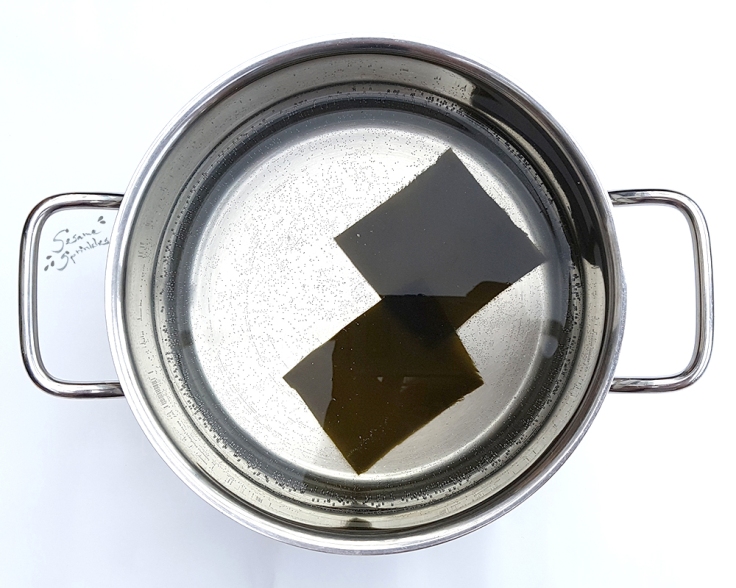
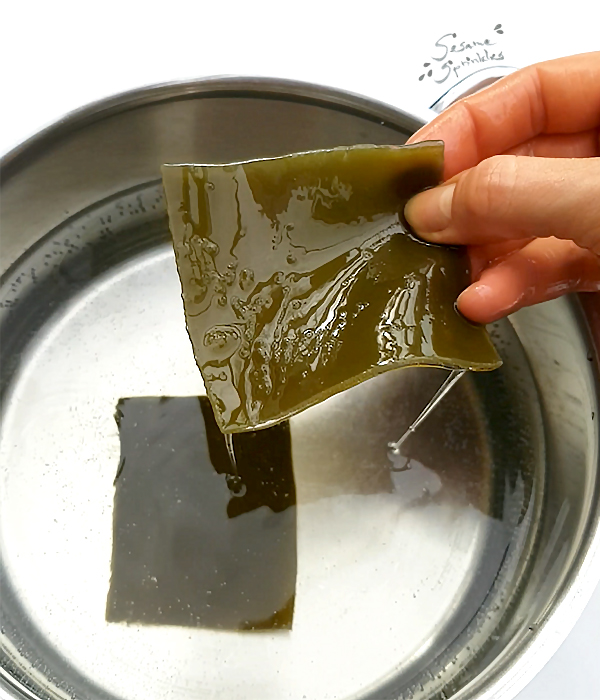







Hi! I’m trying to cook rice porridge using kelp dan anchovies as my stock. Do I throw away kelp after that or can I just keep the kelp while I add other vegs? Thanks.
LikeLike
Hi there! Thanks for your question! Many people discard the kelp after the stock is done, because most nutrients have moved into the broth and it doesn’t look too appetizing to have a big piece of kelp swimming around when serving the soup. But you don’t have to! (I personally keep the kelp in the soup as long as possible and eat it in secret, when noone is watching! 😂)
When you make rice porridge, you could also cut it up finely like the other vegetables and eat it. That way it won’t get wasted!
LikeLike